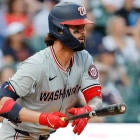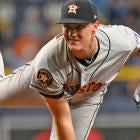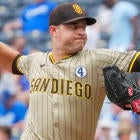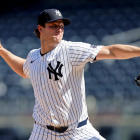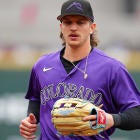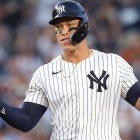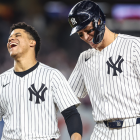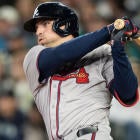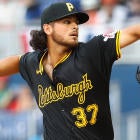The 2009 season is over and the 2010 Hot Stove season is just now heating up, so let's pass the time with a round of "Blame the Manager."
Phillies fans still stinging from their team's defeat may want to kick things off with Charlie Manuel's choice of Pedro Martinez to start two games in the World Series, including the eventual elimination game. While a 3.63 regular season ERA made him look like one of Manuel's best options, a 4.34 ERC suggested that the three-time Cy Young winner got pretty lucky over his 44 2/3 late-season innings. Lurking behind that mediocre stat was an astoundingly high 27 percent line drive rate that showed that Pedro got hit pretty hard during his regular season stint.
It's too late for the Phils to go back and reconfigure their postseason rotation, but if Pedro returns in 2010, is it worth penciling him into your Fantasy rotation? And what bigger lessons can Fantasy owners take away from Pedro's season? One possible lesson is to be wary of Pedro and other hurlers with high line drive rates. If he were to continue to dole out line drives like stuffing at a Thanksgiving dinner, that could spell trouble, as major league hitters typically get base hits on line drives more than 70 percent of the time. That would be the wrong lesson to take away from Pedro's one-year lapse (and, really, it was just seven weeks). As it turns out, there is no such thing as a major league line drive pitcher. And, by the way, Pedro really was pretty sharp in '09.
Sure, there are plenty of line drive hitters. Players like Brad Hawpe, Todd Helton, Manny Ramirez, Michael Young and David Wright log far more than the typical 18 to 20 percent of hit balls for line drives year in and year out. However, pitchers who register line drive rates in the mid 20s or higher don't maintain rates that high for long. Either those rates come down, as health or luck improves, or those pitchers find themselves out of a major league job quickly. Given the chance, Angels rookie Trevor Bell could have put together a season much like, say, Matt Palmer's, but because he got clobbered with a 29 percent line drive rate in his four starts after his early August callup, he rode the pine for nearly all of September. Meanwhile, Palmer milked his 14 percent line drive rate into 13 turns in the rotation and an extended bullpen gig, even though his peripherals were not much better than Bell's. Neither may be a fit for a spot on a major league staff, but the point is that some pitchers miss their chance to stick because of a brief spate of line drives. Pitchers who are able to get big league batters out simply won't sustain a line drive rate much above the average for very long.
Only time will tell if Bell will be able to induce fly outs and ground outs from major league hitters, but there were several more established starting pitchers who also posted sky-high line drive rates in 2009. These pitchers could be some of the biggest draft day bargains in 2010, just as Edwin Jackson and Kevin Millwood were this season. Both Jackson and Millwood pulled off the rare feat of compiling back-to-back seasons with line drive rates over 22 percent, but both pitchers' rates returned to normal in 2009. Brian Bannister (24 percent line drive rate in 2008) and Joel Pineiro (22 percent) were also among the pitchers who improved in '09, thanks in part to the regression of their line drive rates.
The following six pitchers saw their rates soar above 22 percent this season. (Craig Stammen, Scott Richmond and Jason Berken also had line drive rates above 22 percent, but all three are rookies, so for all we know, they are genuinely hittable at the major league level.) Everyone on this list, except for Jarrod Washburn, registered a high batting average on balls in play (BABIP), which would be expected from any pitcher who allowed an above-average proportion of line drives, as opposed to fielder-friendly flyballs and grounders. These five pitchers also have a recent history of normal line drive rates, so there is every reason to think that all of them will perform better next season.
| Player | BABIP | '09 Line Drive Rate | '08 Line Drive Rate | '07 Line Drive Rate |
| Justin Verlander | 0.325 | 23.5% | 18.5% | 17.9% |
| Armando Galarraga | 0.306 | 23.4% | 19.3% | N/A |
| Livan Hernandez | 0.338 | 23.1% | 18.7% | 20.6% |
| Vicente Padilla | 0.311 | 22.7% | 19.5% | 20.1% |
| Jason Hammel | 0.338 | 22.3% | 20.0% | 19.8% |
| Jarrod Washburn | 0.256 | 22.3% | 21.7% | 20.3% |
Verlander's owners should be very happy in 2010. He had a sterling 2009 season, despite a high BABIP, and it appears very likely that he will be yielding even fewer base hits next year. These stats also put Livan Hernandez' future in a different light. After consecutive seasons with a 5.00-plus ERA and a WHIP above 1.55, it would seem to be time for the 34 year-old to hang it up. With more normal line drive and BABIP rates, it would have been clear that 2009 was a comeback season for Hernandez, as his peripherals were his best since 2005. If he catches on with a major league team next spring, he could be a draft or waiver bargain for owners in deeper leagues. Jason Hammel will be a big bargain for mixed league owners, once he mixes in a declining BABIP with his groundball tendencies and rapidly improving strikeout and walk rates.
And finally, there is Washburn, whose '09 season defied logic from start to finish. The lefty's skill ratios (K/9, BB/9, HR/9) were very similar to those from '08 and his batted ball profile was similar as well, yet he chopped nearly a full run from his ERA. Much of the improvement can be traced to his batting average against on line drives. According to Baseball-Reference.com, in 2008, batters went 79-for-114 (.693) on line drives off Washburn, but in 2009, they went 80-for-128 (.625). It is unlikely that Washburn will give up as many liners in 2010, but he will probably give up more hits on the ones he does allow. At best, call it a wash for Washburn.
While there is no such thing as a major league line drive pitcher, there are a few pitchers who have consistent success in preventing line drives. The table below shows the starting pitchers with the lowest line drive rates in 2009, and among them, Hiroki Kuroda and Brian Moehler seem to have a genuine knack for avoiding the frozen rope. The list certainly skews towards ground ball pitchers, and sinkerballers Tim Hudson and Derek Lowe have also managed consistently low line drive rates throughout their careers. Because most of the pitchers on this list sport low flyball rates, the impact of their line drive rates on BABIP is muted. Not surprisingly, flyballers Ross Ohlendorf and Jonathan O. Sanchez have two of the lowest BABIPs on the list.
| Player | BABIP | GO/AO | '09 Line Drive Rate | '08 Line Drive Rate | '07 Line Drive Rate |
| Hiroki Kuroda | 0.278 | 1.58 | 0.153 | 0.157 | N/A |
| Ross Ohlendorf | 0.273 | 0.98 | 0.155 | 0.237 | N/A |
| Jonathan O. Sanchez | 0.279 | 0.94 | 0.155 | 0.193 | 0.175 |
| Brian Bannister | 0.299 | 1.31 | 0.155 | 0.236 | 0.207 |
| Joel Pineiro | 0.297 | 2.39 | 0.157 | 0.224 | 0.187 |
| Ryan Dempster | 0.311 | 1.36 | 0.157 | 0.169 | 0.224 |
| Joe Saunders | 0.291 | 1.39 | 0.159 | 0.154 | 0.223 |
| Manny Parra | 0.356 | 1.38 | 0.159 | 0.203 | N/A |
| Brian Moehler | 0.322 | 1.28 | 0.159 | 0.163 | 0.181 |
The low line drive rates for Ohlendorf, Sanchez, Brian Bannister and Joel Pineiro are out of line with their norms, so we can expect each of them to give up more liners and more base hits next year. Despite a line drive rate that is sure to rise, Manny Parra should still improve in '10, as long as batters don't continue to pound liners off him for a .829 batting average, like they did this year. Next season should be a telling one for Ryan Dempster and Joe Saunders, as both have been very good at avoiding line drives in back-to-back years. If this has merely been an extended period of good luck for them, they could experience a dip in Fantasy value for 2010.
A change in line drive rates won't convert a Triple-A pitcher into a mixed league stalwart or turn an ace into a scrub, but it is a useful indicator that can help owners spot overvalued and undervalued pitchers on Draft Day. Someone like Armando Galarraga could be next year's Kevin Millwood, scaring off all but the most desperate owners at draft and auction time, but becoming more popular as the season wears on and his true value is revealed. Likewise, Ross Ohlendorf could be next year's Fausto Carmona, wildly overrated because the previous season's line drive rate masked a mediocre set of peripherals. Line drive rates may not be at top of your draft cheat sheet, but making a note of these aberrant cases may net you a bargain or spare you a disappointment in the season to come.
|
|
|
Runs Created per 27 Outs (RC/27) -- An estimate of how many
runs a lineup would produce per 27 outs if a particular player
occupied each spot in the order; ex. the RC/27 for Miguel Cabrera
would predict the productivity of a lineup where Cabrera (or his
statistical equal) batted in all nine spots; created by Bill James Component ERA (ERC) -- An estimate of a what a pitcher's ERA would be if it were based solely on actual pitching performance; created by Bill James GO/AO -- Ground out-fly out ratio GB/FB -- Ground ball-fly ball ratio Batting Average per Balls in Play (BABIP) -- The percentage of balls in play (at bats minus strikeouts and home runs) that are base hits; research by Voros McCracken and others has established that this rate is largely random and has a norm of approximately 30% Isolated Power -- The difference between slugging percentage and batting average; created by Branch Rickey and Allan Roth Walk Rate -- Walks / (at bats + walks) Whiff Rate -- Strikeouts / at bats |
Al Melchior was recently a Fantasy columnist and data analyst for Baseball HQ and will be providing advice columns for CBSSports.com. Click here to send him a question. Please put "Melchior" in the subject field.













